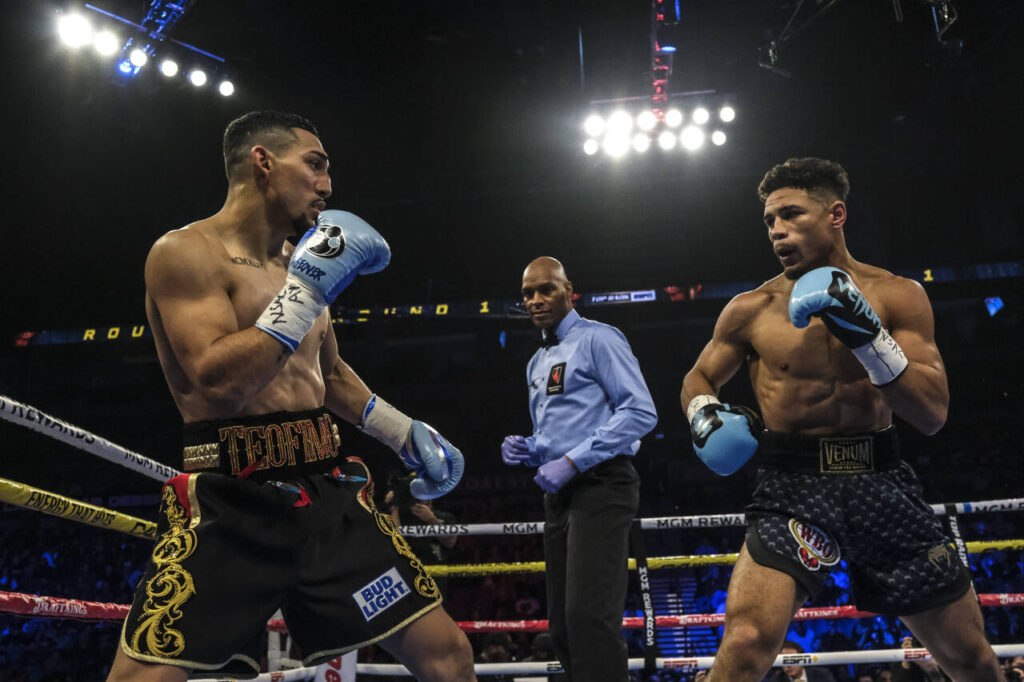
Table of Contents
Mikaela Mayer and Natasha Jonas delivered this weekend, throwing down for a brilliant back-and-forth battle that ended in controversy. Jonas walked away with the split decision, but with most fans seeing the scoring for Mayer, there has been some outcry. I personally scored it a draw live, and 6-4 for Mayer on a rewatch, so I can see why fans are upset. On the other hand, I can see six rounds you could give to Jonas, so while that’s generous scoring I don’t think it goes so far as being a robbery.
What we shouldn’t do though is let that overshadow what was a fantastic fight, full of both action and tactical adjustments that we can get our teeth into. So let’s do that.
The Breakdown: How Mikaela Mayer vs. Natasha Jonas went down
However you eventually scored it, this was pretty much a case of Jonas dictating the tempo early before Mayer made her adjustments and ended up taking over late — though there was plenty of back-and-forth in between.
Mayer’s biggest problem in the early rounds is that she consistently set her feet to throw before she’d sufficiently closed distance, while Jonas stepped off rather than stepping forward. This left Mayer reaching, off-balance, which gave Jonas time and space to deliver her typical crisp, straight shots before moving to safety. The champion also focused pretty consistently on the body, in particular with a lovely little right-hand shovel hook to the ribs as she pivoted out.
There may have been a stance-reading issue here — this was seemingly the first time Mayer had faced a southpaw as a pro, certainly the first one of any high level. An open-stance matchup leaves more ground to cover to get power hands home, and Mayer didn’t initially seem comfortable with that.
She got busier and more aggressive in rounds two and three, with Jonas responding in the third, holding her own feet a little more to deliver longer combinations and try to impede the movement with intercepting shots. It wasn’t really till round four, though, that Mayer made her first genuine tactical advantage, one that changed the fight.
It was a pretty simple one — she’d start taking an extra step in before throwing her power shots, and if Jonas backed out on time, she stopped being so ready to commit anyway. Interestingly, at times she achieved this by not throwing her lead hand, against common wisdom — essentially, Jonas had been reading her pattern of stepping in with either a lead hook or a double jab before she threw the right, and by abandoning it for some of the time, Mayer eliminated a tell and let her take that step unexpectedly.
That stopped her overbalancing, and it also meant Jonas had less space to work her pivots and sidesteps. As the round closed she also did a good job of predicting Jonas’ movement and cutting it off, which eventually let her push the champ to the ropes and let a few solid punches go at the end.
Jonas’ coach, Joe Gallagher, gave her a talking to about that in the corner, telling her she was relying too much on tapping shots that were allowing Mayer to set up shots without any danger. The response was to, at least part of the time, abandon the back-foot boxing, and step in to slug it out and carve out the space she needed that way. She would still step off, but from here on out she had a much heavier focus on landing hard shots before Mayer threw, rather than as counters, and she was more willing to accept the clinch.
That clinch and close-range pocket battle proved interesting technically, with contrasting strengths playing off each other. Jonas, even there, had the better footwork, able to get the better of it in moments where she could adjust with a small angle to get off-line and find some space. On the other hand, Mayer seemed to have the better ability to physically control her opponent, both with sheer strength and with some neat framing and posture.
That meant that, in contrast to the range game, in close it was Jonas who was often off-balance. It also meant Mayer was able to bring her own bodywork into play, and the combination of those things may have turned the fight. By the end, it was clearly Jonas who was feeling the pace more. She wasn’t even necessarily more tired (until the final round, where she definitely was). It was just that for her game to work smoothly she needed to be pin-sharp and clean, and as she tired she got less so. Mayer was the more ragged from the start, but as she tired she didn’t significantly lose effectiveness.
Rounds six through eight were a great stretch of the fight, with the pair going toe-to-toe and exchanging combinations to body and head. After that, Mikaela Mayer took over, and pretty convincingly won the last two. By the end, Jonas was starting to unravel, and will probably be thanking her lucky stars that this was ten two-minute rounds, because a 3-minute 12 rounder would have spelled trouble for her on this evidence.
Still, she got the cards from two of the judges, and thus the victory. Mayer wasn’t happy, but both were gracious about the situation afterwards.
The Future: What’s next for Mikaela Mayer and Natasha Jonas?
Well, both us as fans and Mayer will be hoping for the rematch. It’s been made clear that Jonas was the only one with a clause guaranteeing one, so we’ll see. Jonas has said she’ll do so if the fans make it clear they want it — whether that’s true remains to be seen.
Other than that, Jonas also said that this is the last year of her career — which at 39 years of age isn’t surprising. There aren’t really a great many options for her at these higher weights, so a rematch then a softer-touch retirement fight, win or lose, would seem to be a fairly logical path through the year.
Mikaela Mayer has been open about the fact that she wants the biggest name, highest challenge fights, and that the reason she took this jump up in weight is that the other big names lower down were occupied with each other. As that situation clears up, she may move back down — though given how comfortable she looked at welter, it may not be easy for her anymore. Still, Katie Taylor and Chantelle Cameron are only a division down (and Cameron in particular may want to move up at some stage). Plus Jessica McCaskill is at welter currently. So there are good options for her without cutting too much weight.
Join us on Substack
You know you can count on us for quick, consistent quality MMA and boxing coverage. Bloody Elbow is an independent, reader supported publication. Please subscribe to our newsletter to keep up with our best work and learn how you can support the site.
About the author



